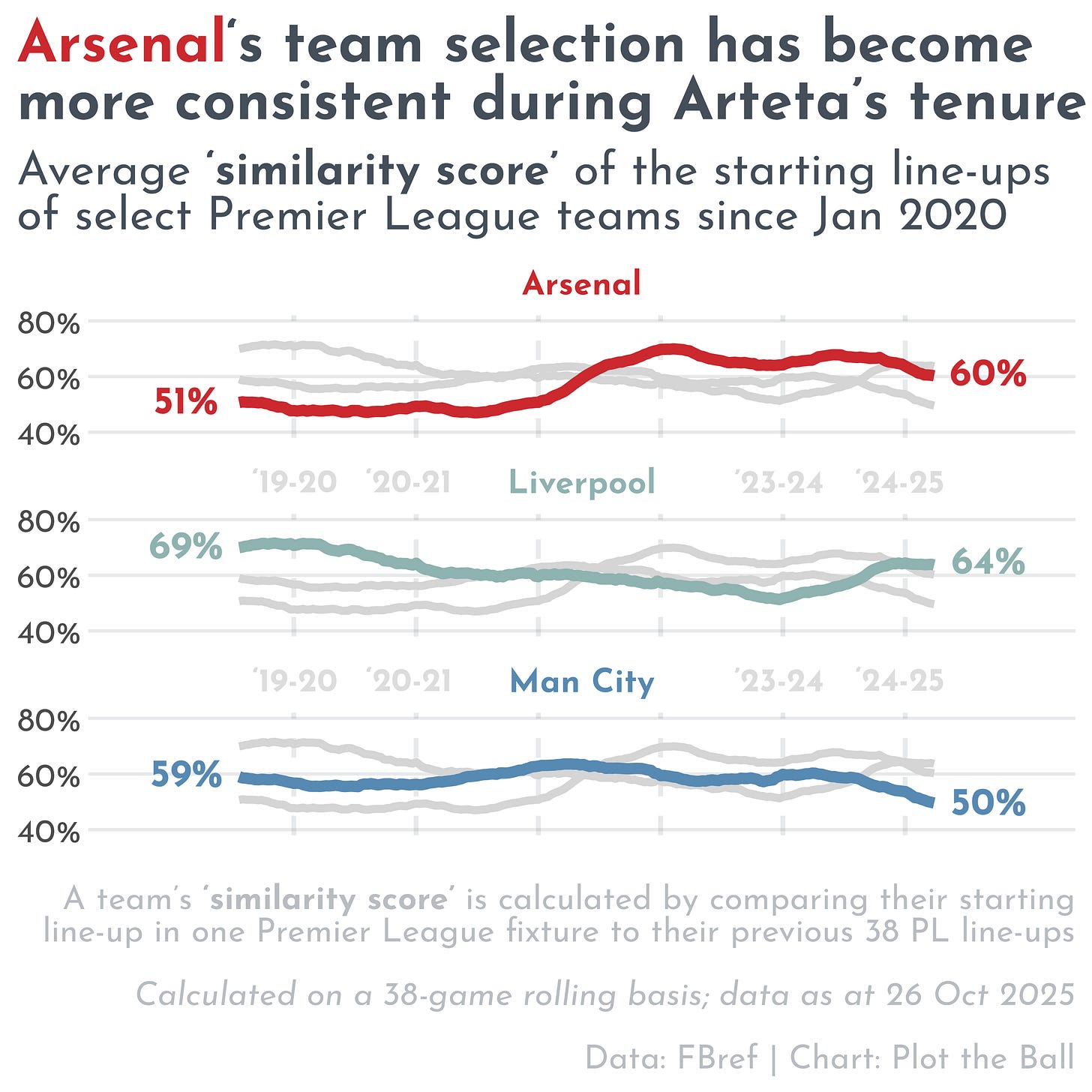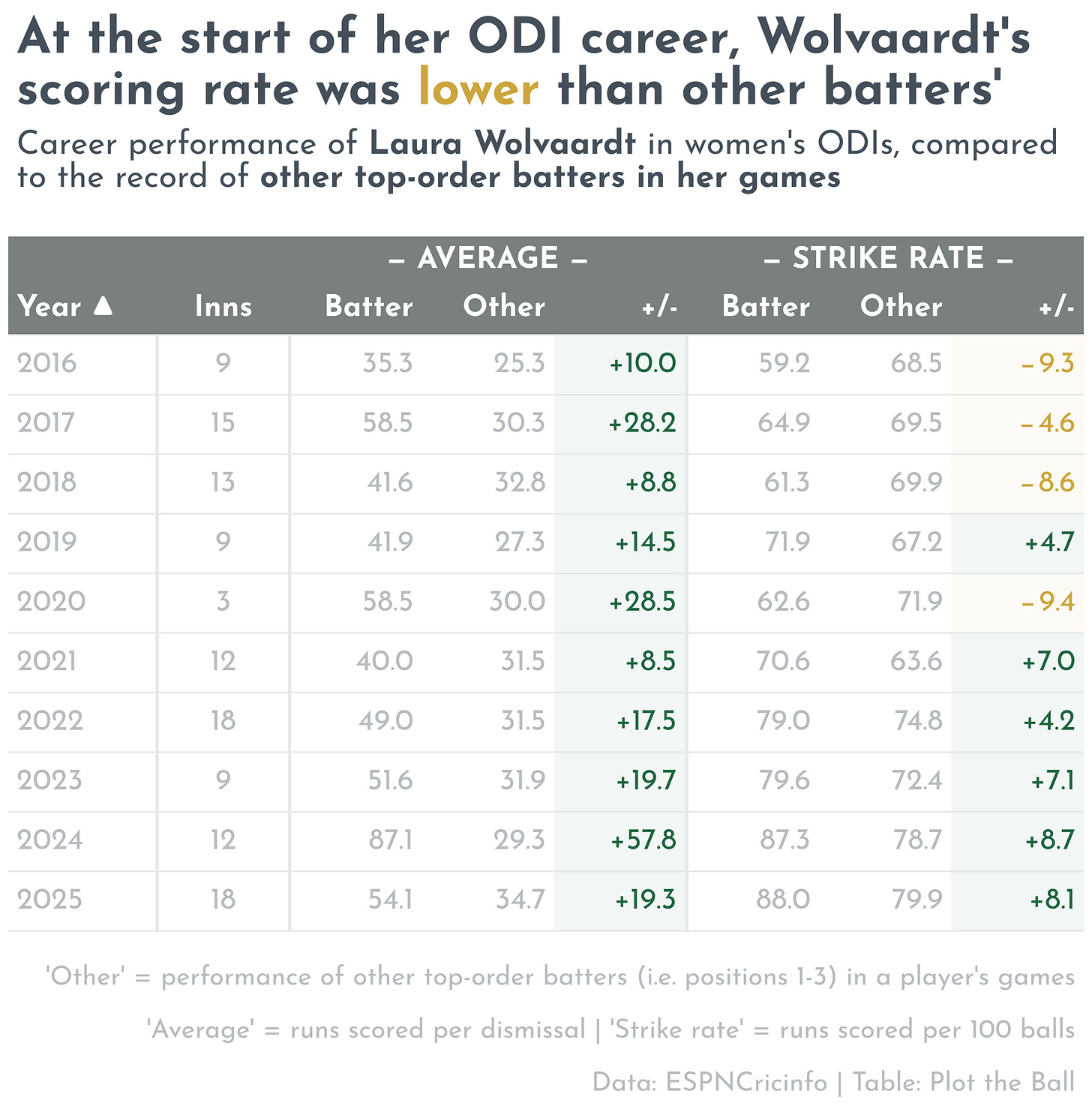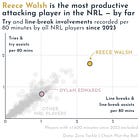⚽️ Consistent selection made Arsenal a contender — and new talent might finally take them to a title
My Week in Sport(s) ⚽️ 🏏 🏉 ⚾️ 🏒
Welcome to My Week in Sport(s) — a regular newsletter from Plot the Ball.
Covered in this edition: ⚽️ Arsenal, 🏏 Laura Wolvaardt, 🏉 Ireland, ⚾️ Yoshinobu Yamamoto and 🏒 Macklin Celebrini.
⚽️ Consistent selection made Arsenal a contender — and new talent might finally take them to a title
I’ve got no idea whether Mikel Arteta has ever heard of Ivan Cleary. They’d have a lot to talk about together, though: I’d be surprised if Arteta didn’t recognise some of the team-building principles Cleary’s Penrith Panthers have put in place in the NRL.
Like Arteta’s Arsenal, the Panthers have become one of their league’s best teams in recent years on the back of a dominant defence. Like Penrith, Arsenal constructed a strong spine by consistently selecting talented players in key positions. The chart below plots the ‘similarity score’ of the team’s Premier League starting line-ups since Arteta took over, and compares their score to their rivals. I’ve used this metric before to roughly gauge whether a coach is doing what they can to build on-field cohesion.
When the Spaniard took over at the end of 2019, Arsenal’s score was trailing behind those of Liverpool and Man City. By 2022-23, it was clearly trending upward — and they were selecting the most consistent line-ups of the ‘big three’ for almost the entirety of the next two seasons. So far in 2025-26, however, this number has slightly dropped off. Despite a commanding lead in the table, they’re now actually trailing Liverpool — who are in third place — by a number of percentage points in this metric.
How can we explain this? Regarding Liverpool, I might point to the fact that their two most important players — who have played almost every minute for the team in the Premier League this season — are now over the age of 33, and likely on the decline. In Arsenal’s case, I’d be inclined to credit the defensive talent of the players Arteta is now featuring regularly. Since his arrival from Real Sociedad this past summer, for instance, Martín Zubimendi has been nearly ever-present in their midfield.
In addition, highly-rated defensive recruits Jurriën Timber and Riccardo Calafiori are both playing more than 80% of the minutes. (Before the current campaign, they had combined to play just 34% of the available minutes since signing with the club.) Even ardent advocates of a cohesion-based approach to squad-building acknowledge that talent remains a key driver of performance; however, we shouldn’t underestimate the stability of the surrounding system that is allowing Arsenal’s new additions to thrive.
🏏 South Africa captain Laura Wolvaardt has matured into a multi-faceted ODI batter
Smriti Mandhana and India won the Cricket World Cup final last Sunday. The top-order batter had a solid tournament — but it was the captain of the losing finalists, South Africa, who really stole the show in its latter stages.
Laura Wolvaardt was this World Cup’s highest run-scorer overall, and recorded centuries in both of her team’s knockout fixtures. She and Mandhana are set to be the standout batters of their generation; a couple of months ago, though, I wrote about how Mandhana had displayed a broad range of white-ball skills more consistently than Wolvaardt. While the Indian’s career aggregate remains more impressive, this tournament allowed Wolvaardt to show off how much her own game has grown.
Wolvaardt debuted at 16, and immediately proved herself as a reliable run-scorer. (She has never recorded an ODI average lower than expectation in a calendar year.) At the start of her career, she accumulated those runs at a much slower pace than her peers — but, over the years, her strike rate has trended upwards. And Wolvaardt’s last two years have been her best yet: in both 2024 and 2025, she has scored over eight runs per 100 balls more than the other top-order batters in the ODIs she has played.
What else I learned last week
🏉 Ireland’s attack has declined considerably since the 2023 World Cup
The last men’s Rugby World Cup ended in failure for Ireland and their retiring fly-half, Jonny Sexton. I’ve previously made the case that they were nonetheless the best team in the world at the end of 2023; that case is a lot more difficult to make now.
My team strength model currently rates Ireland as nine points per game better than the average ‘Tier 1’ side — down from a mark of +14 two years ago. Almost all of that regression has been with the ball: they scored six points per game more than average at that time, but today — after losing to New Zealand last week — the team sits at an ‘attack rating’ of +2. Sexton is now an assistant coach, and earlier this week made the comparison to 2023 himself: “If you looked at Saturday, you’d say we’re miles away.”
⚾️ Yoshinobu Yamamoto doubled his workload during LA’s playoff run
I’ve written before about how NBA teams change their distribution of minutes in a simple way during the playoffs: their stars tend to play more than they did in the regular season. In this year’s MLB postseason, there was a similar trend at play.
The Los Angeles Dodgers took out a second consecutive World Series last Saturday, and star pitcher Yoshinobu Yamamoto was credited with three of their four wins. We can capture how much influence the 27-year-old had on this year’s playoffs more precisely with another simple metric, though. During this regular season, Yamamoto — who started more games than anyone else on the team — completed 12% of all innings pitched by the Dodgers. In the playoffs, his share almost doubled to 23%.
🏒 Macklin Celebrini is already great at getting his team on the power play
The San Jose Sharks still aren’t a sustainably good hockey team with teenage starlet Macklin Celebrini on the ice. This season, they have accounted for 60% of the goals scored in his even-strength minutes — but only 40% of the expected goals created.
However, Celebrini has already shown enough that his peers believe he will become the next face of the NHL. What makes him special? I looked at his ability to progress the puck up the ice last year; since entering the league, he has also been great at generating power-play opportunities for his team. Celebrini is one of 99 forwards to have played at least 1,600 minutes since the start of the 2024-25 season — and he’s drawn a penalty offence from an opponent more frequently than all but four of them.
The next edition of My Week in Sport(s) will be published on Friday November 14th.





